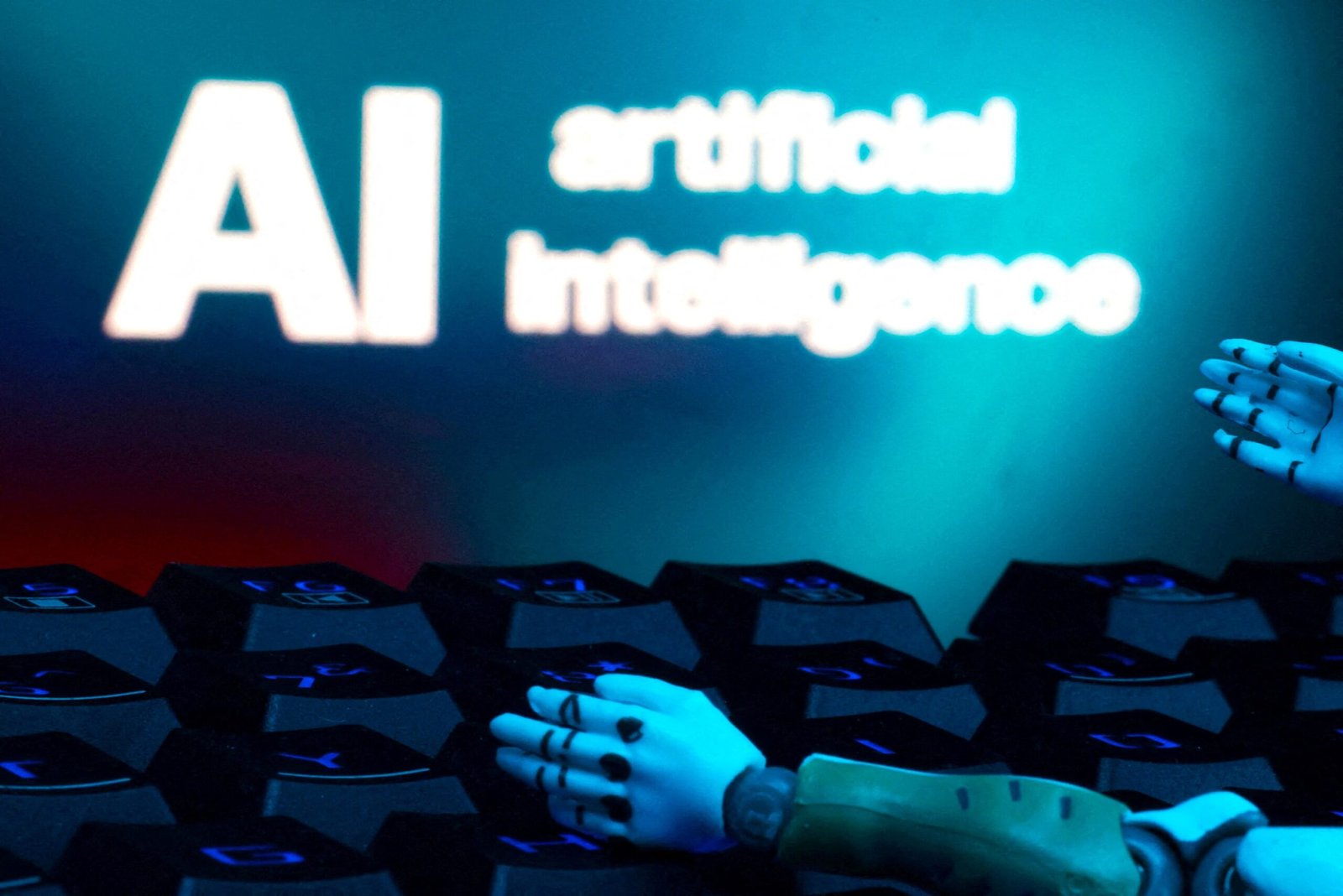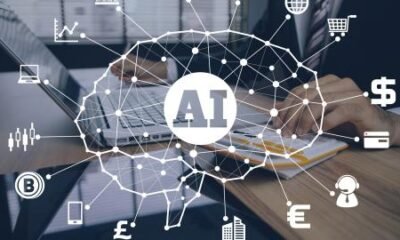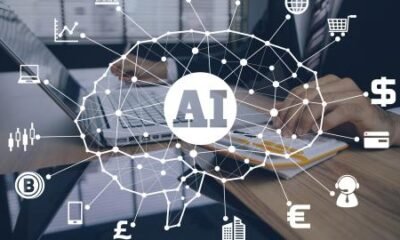AI Insights
AI dooms the billable hour – and Big Law earnings

A message reading “AI artificial intelligence,” a keyboard and robot hands are seen in this illustration created on January 27, 2025. REUTERS/Dado Ruvic/Illustration/File Photo
LONDON, July 2 (Reuters Breakingviews) – Artificial intelligence promises to save time for white-collar workers. If true, that could be bad news for companies that bill clients by the hour. Law firms, auditors and other professional-services outfits might find ways to mitigate the financial hit. But there’s no getting around the fact that automation risks devaluing part of the pricey service they’re offering.
Sign up here.
One problem with this option, other than its heartlessness, is that firms need a constant pipeline of juniors to repopulate the partnership. Who else will replace the old guard when they finally cash out to hit the golf course full time? It’s also far from clear that the hallucination-prone software is ready for the big time, implying that a horde of associates may still be needed to check AI agents’ accuracy.
That points to a different solution: moving away from billable hours. It’s already happened at the elite strategy consultancies like McKinsey & Company, Bain & Company and Boston Consulting Group, who often charge flat project fees tied to specific outcomes.
But it’s a different type of service to advising on a complex deal or piece of litigation. The risk is that it will be tough to systematise pricing across the vast variety of projects. Doing so might be easier for beancounters, since audits can in theory share a common overarching process. But no two lawsuits, for example, are the same. Switching to a project-fee approach puts the onus back on professional-services firms to judge how many resources a clients’ work will take.
Yet clients may balk if Big Law tries to apply the same logic to an AI agent. Why should a White Shoe firm add a markup to software that it just bought from someone else? Corporate clients could argue that they could just get their own AI agents instead. It’s a management challenge that Hale and Dorr’s attorney mastermind Reginald Heber Smith would probably have relished. Solving it will require moving beyond the billable hour.
Editing by Liam Proud; Production by Streisand Neto
Our Standards: The Thomson Reuters Trust Principles.
AI Insights
Beyond public services, Gyeonggi Province leads South Korea’s AI push | MLex
By Choonsik Yoo ( September 2, 2025, 07:23 GMT | Insight) — Gyeonggi Province, South Korea’s most populous region, is aggressively adopting artificial intelligence to enhance public services and streamline operations, while also implementing a policy intended to increase citizen trust. The province has already introduced welfare-focused applications such as a Solitary Death Prevention and Response Service and AI-applied monitoring systems for children with developmental disabilities, and now aims to use its strong technology base by pursuing nine AI strategies and 52 projects.
At the heart of South Korea’s tech-savvy landscape, Gyeonggi Province is pushing ahead with an ambitious embrace of artificial intelligence not only to enhance public services and internal operations but also to open fresh avenues for business growth in the country’s most populous and strategic region….
Prepare for tomorrow’s regulatory change, today
MLex identifies risk to business wherever it emerges, with specialist reporters across the globe providing exclusive news and deep-dive analysis on the proposals, probes, enforcement actions and rulings that matter to your organization and clients, now and in the longer term.
Know what others in the room don’t, with features including:
- Daily newsletters for Antitrust, M&A, Trade, Data Privacy & Security, Technology, AI and more
- Custom alerts on specific filters including geographies, industries, topics and companies to suit your practice needs
- Predictive analysis from expert journalists across North America, the UK and Europe, Latin America and Asia-Pacific
- Curated case files bringing together news, analysis and source documents in a single timeline
Experience MLex today with a 14-day free trial.
AI Insights
Teens are using AI. Here’s how parents can talk about it. : Life Kit : NPR

High school and college students graduating in 2026 will have had access to artificial intelligence models like ChatGPT since their freshman year. Teens are using it in creative ways to help them study, but many have also received little to no guidance on responsible use. In this episode, we discuss how to talk to teens about AI, including its risks and potential benefits for young people.
Follow us on Instagram: @nprlifekit
Sign up for our newsletter here.
Have an episode idea or feedback you want to share? Email us at lifekit@npr.org
Support the show and listen to it sponsor-free by signing up for Life Kit+ at plus.npr.org/lifekit
AI Insights
How Artificial Intelligence Creates Billionaires

Tehran – BORNA – Artificial intelligence is generating wealth at a speed never seen before, creating dozens of new billionaires and pushing the valuations of startups and tech giants to astronomical levels. This trend has turned AI into the fastest wealth-creation wave of the modern era.
In recent years, AI has evolved from an emerging technology into a global economic and financial powerhouse. This wave is not only transforming industries but also producing unprecedented fortunes. In the current year alone, dozens of new billionaires have emerged from AI-driven companies and startups.
An Unprecedented Investment Boom in AI
Massive funding rounds for AI startups such as OpenAI have pushed company valuations and investor wealth to record highs. Huge venture capital inflows and backing from major investors have created fortunes that are staggering yet real in the tech world. These investments allow private companies to expand rapidly and develop advanced products, while simultaneously fueling the emergence of a new billionaire class worldwide.
According to Andrew McAfee, researcher at the Massachusetts Institute of Technology (MIT), “If you look at the past 100 years of data, we’ve never witnessed wealth creation at this scale and speed.” He argues that this phenomenon is driven by a combination of soaring stock prices at big tech firms and massive investments in young startups unlike anything in modern economic history.
The Role of Big Tech
Major corporations such as Nvidia, Meta, and Microsoft are among the core engines of AI wealth. Their rising stock prices have enriched institutional and retail investors alike, while also benefiting executives and employees. Founders and leaders of AI startups collaborating with these tech giants have seen the value of their equity surge, quickly joining the ranks of the world’s newest billionaires.
The Rise of AI Unicorns
According to CB Insights, there are now 498 private AI companies valued at over \$1 billionthe so-called “AI unicorns.” Together, these firms represent a combined valuation of about \$2.7 trillion. Remarkably, around 100 of them were founded since 2023, highlighting both the rapid pace of AI entrepreneurship and investors’ intense appetite for the sector.
This shows that AI is not only a transformative technology but also a powerful economic and investment driver. Inspired by the success of tech giants and the explosive growth of startups, investors are increasingly willing to pour money into AI ventures.
AI and Personal Wealth Creation
The rapid creation of wealth extends beyond companies. Individuals including founders, executives, engineers, and even startup advisors have quickly joined the global billionaire ranks. Through equity stakes and performance-based rewards, many have significantly boosted their personal fortunes. This demonstrates that in the AI era, financial opportunities are not limited to institutional investors; creative and innovative individuals can also capitalize on this boom.
Economic and Social Consequences
This historic wave of wealth creation carries wide-ranging economic and social implications. On one hand, the concentration of capital and enormous fortunes in the tech sector risks worsening inequality, as wealth increasingly accrues to those with access to investment networks and technological opportunities. On the other hand, greater financial resources for companies and startups accelerate the development of new technologies and services, driving growth and job creation in related industries.
The rapid rise of AI unicorns has also intensified competition between startups and established corporations. Companies now face pressure to continuously innovate, invest in research and development, and secure top talent to maintain their competitive edge. This cycle drives faster technological breakthroughs and the launch of new products and services.
AI and the Future of Investment
Investors and financial experts regard AI as one of the most promising fields for the coming decades. The rapid rise in valuations, the increase in billionaires, and the sheer pace of wealth creation all underscore AI’s status as an unprecedented economic force.
Analysts caution, however, that AI investments carry significant risks. Stock market volatility, potential startup failures, and disruptive technological shifts could quickly erase capital. Yet the sector’s profitability potential and rapid wealth-generation capacity continue to attract global investors.
Artificial intelligence is rapidly becoming one of the world’s most powerful economic and financial engines. It is reshaping industries, fueling an unprecedented wave of wealth, and creating fortunes across corporations, startups, and individuals.
Despite risks and uncertainties, the explosive growth of AI companies, the emergence of new billionaires, and the astronomical valuations demonstrate that AI is shaping nothing less than an economic and investment revolution. For investors, entrepreneurs, and policymakers, the message is clear: AI is not only the technology of the future but also the driving force of wealth creation in the decades ahead.
End article
-

 Business4 days ago
Business4 days agoThe Guardian view on Trump and the Fed: independence is no substitute for accountability | Editorial
-
Tools & Platforms3 weeks ago
Building Trust in Military AI Starts with Opening the Black Box – War on the Rocks
-

 Ethics & Policy1 month ago
Ethics & Policy1 month agoSDAIA Supports Saudi Arabia’s Leadership in Shaping Global AI Ethics, Policy, and Research – وكالة الأنباء السعودية
-

 Events & Conferences3 months ago
Events & Conferences3 months agoJourney to 1000 models: Scaling Instagram’s recommendation system
-

 Jobs & Careers2 months ago
Jobs & Careers2 months agoMumbai-based Perplexity Alternative Has 60k+ Users Without Funding
-

 Funding & Business2 months ago
Funding & Business2 months agoKayak and Expedia race to build AI travel agents that turn social posts into itineraries
-

 Education2 months ago
Education2 months agoVEX Robotics launches AI-powered classroom robotics system
-

 Podcasts & Talks2 months ago
Podcasts & Talks2 months agoHappy 4th of July! 🎆 Made with Veo 3 in Gemini
-

 Education2 months ago
Education2 months agoAERDF highlights the latest PreK-12 discoveries and inventions
-

 Podcasts & Talks2 months ago
Podcasts & Talks2 months agoOpenAI 🤝 @teamganassi






















